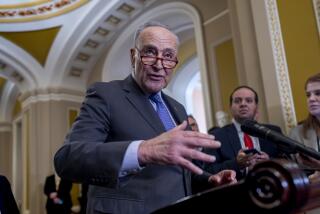Senators Keep Space Station Alive
WASHINGTON — Ignoring the doubts of leading scientists, the Senate Wednesday ensured that the nation’s controversial program to build Space Station Freedom will survive for at least one more year.
After a divisive debate that pitted supporters of the nation’s manned space program against those who argued for deficit reduction or increased social spending, the Senate rejected by a 64-35 vote an attempt to slash nearly all of the proposed $2 billion in space-station funding for the 1992 fiscal year.
At McDonnell Douglas in Huntington Beach where about 1,200 of the 7,000 employees work on the space-shuttle project, the vote was greeted with “a lot of smiles, some great cheers and one whoop!” said company spokesman Tom Williams.
“Man has got to go into space,” added Williams. “Because it’s in man’s nature to conquer . . . to explore. As someone said, if Fernando and Isabella had had to answer to a GAO (General Accounting Office), Christopher Columbus would never have got off.”
The amendment to dismantle the program was offered by Sen. Dale Bumpers (D-Ark.), who argued that the project is an exorbitant luxury that the nation can ill afford.
The vote to continue space station funding came as the Senate considered an $80.9-billion appropriations bill for housing, veterans affairs and independent government agencies, including the National Aeronautics and Space Administration. Debate on the full bill continued Wednesday evening.
The House already has approved spending $1.9 billion on the space station in fiscal 1992. The difference between the two figures will be ironed out later in a House-Senate conference committee. The Bush Administration has strongly supported the space station project and had vowed to veto an appropriations bill that eliminated funding for the program.
The Senate action capped months of debate over the future of the planned orbiting space platform, which is intended to serve as a laboratory for life sciences and microgravity research and as a jumping off point for a return to the moon and a possible manned mission to Mars.
In recent months, members of the scientific community have complained that a redesign of the station ordered last year by congressional appropriators to cut costs has reduced the station’s scientific capabilities to the point that it is no longer worth launching.
Just last week, the leaders of 14 scientific societies said in a letter to key senators that “ . . . the excessive cost of the proposed space station threatens the vitality not only of NASA’s science and technology programs, but those of other independent agencies.”
But the Senate rejected that argument.
“I personally am offended by these scientific groups,” said Sen. Jake Garn (R-Utah), a strong NASA supporter who flew on an April, 1985, mission on the space shuttle Discovery. “Some of them are simply opposed to men and women being in space.” Others, he said, erroneously believe that their scientific programs will receive more money if funds for the space station are eliminated.
In his amendment, Bumpers proposed reducing the $2.03 billion that a Senate Appropriations subcommittee had approved for the space station to just $100 million. The leftover money would have been enough to fund studies on alternatives to NASA’s approach to the space station.
Among those who disagreed were California’s two senators, Democrat Alan Cranston and Republican John Seymour. California aerospace firms have billions of dollars in contracts riding on the space-station program. Besides McDonnell Douglas Space Systems in Huntington Beach, the other major space-station contractor is Rockwell International’s Rocketdyne Division in Canoga Park.
NASA already has spent more than $5 billion on space-station development. For McDonnell Douglas, the project is worth $3.4 billion from its start in 1988 to expected completion in 1999. In the 1991-92 fiscal year alone, it is expected to be the “biggest piece of business in Huntington Beach,” constituting 35% of the company’s workload there and worth “hundreds of millions of dollars,” Williams said.
For now, workers are building engineering models of the station, but by 1994 they will begin “bending metal” for the station, Williams said.
The manned platform will hold four astronauts at first, eventually up to eight, for periods of 90 days. The station will orbit about 200 nautical miles above the earth, studying such questions as man’s response to long duration in space and to zero gravity.
NASA estimates total development costs for the shuttle through the year 2000 at $30 billion. However, the General Accounting Office has said that station costs through the end of the decade are likely to total $40 billion. The GAO also estimated that the cost to operate the station through the year 2027, including the $40 billion in development expenses, would come to $118 billion.
Times staff writer Lanie Jones contributed to this story from Costa Mesa.
More to Read
Sign up for Essential California
The most important California stories and recommendations in your inbox every morning.
You may occasionally receive promotional content from the Los Angeles Times.









